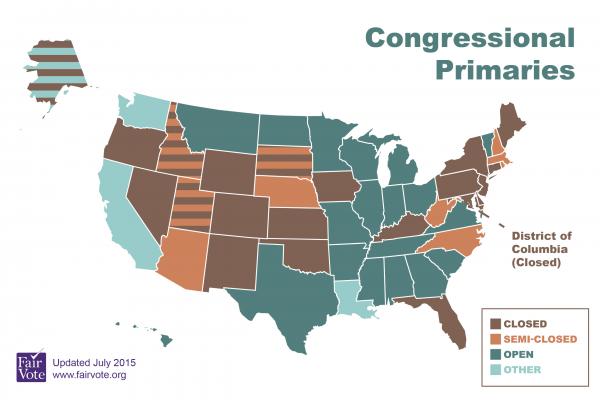Will You Be Able to Vote in the 2016 Congressional Primaries?

When it comes time to vote in the 2016 congressional primary elections, will you be allowed to vote in the primary of your choice? We’ve updated our analysis on every state’s rules for its primary elections: open primaries, closed primaries, “semi-closed” primaries, and the handful of states that do something else entirely. Click here to see the updated page.
The use of publicly funded primary elections to nominate candidates who then appear on the general election ballot is common in the U.S. today, but it is actually highly abnormal, both historically and internationally. We have identified only two other countries that use them: In Colombia, publicly administered primary elections are an option for political parties, and in Uruguay uses them for presidential nominations. Not only did the U.S. not have primaries as we know them today for the first 100 years of its history, during that period it did not even use secret ballots with names printed on them. For much of U.S. electoral history, voting meant writing the names of candidates on paper and putting that paper into a ballot box.
This history helps to explain why, as publicly administered primary elections became more and more common, states adopted them in different ways. Then, as the primary election took on different degrees of significance in different places, the processes deviated even further. In some states, the state parties have a great deal of control over their nomination processes, while in others they have almost none. Some states have a tradition of allowing all voters to vote in any primary, others restrict it to party members or party members and unaffiliated voters. In a few states, the Democratic Party primary has very different rules from the Republican Party primary. Some states do not hold primary nominating contests at all.
These rules are poorly understood, but they are important. Voters need to know what contests they can and cannot participate in, and this information is critically important background to the question of primary election reform.
As partisanship increases, we begin to see more and more general election decisions being made at the primary stage. Rules vary state by state in terms of when primaries happen and who may vote in those elections. We have monitored and updated information since the 2012 primary season including a more comprehensive overview of the types of primaries held by the various states and updates to state rules.
- Alaska’s Republican primary now allows unaffiliated and independent voters to vote alongside registered Republicans. All other parties in Alaska run in a blanket primary open to any registered voter. Voters who take the Republican primary ballot may not vote in the blanket primary and vice-versa.
- Colorado’s primary remains closed; however, the notes have been updated to reflect the fact that unaffiliated voters may declare a new affiliation at the polling place in order to vote in a primary contest.
- Illinois’s primary is now listed as open. Although there is a challenge process it is unlikely that a challenge will actually prevent a voter from voting in the primary of their choice.
- Kansas has been updated to list both parties as having closed primaries. Unaffiliated voters are permitted to affiliate at the polling place but cannot vote in either primary and remain unaffiliated.
- Louisiana’s description has been updated to reflect the fact that in congressional races, they hold no primary election at all, but rather a general election followed by a contingent runoff election if no candidate wins with a majority vote. Louisiana is unique in this respect.
- New Hampshire has been updated to reflect that parties allow unaffiliated voters to affiliate at the polls and those voters may remain unaffiliated in subsequent elections by filling out a form.
- Utah has been updated to reflect the changes made to the process of getting on the primary ballot. Additionally, if no candidate receives at least 40% of the vote in the primary, the party’s delegates may choose the party’s nominee.
We have not yet updated the rules listed for presidential primaries and caucuses, so they reflect the rules as of the 2012 election. We plan to update those rules soon, though as we approach the 2016 nominating season, we also expect state parties to consider changes to their rules which will undoubtedly be fiercely debated.
As these updates reflect, primary rules vary widely and can change quickly. If you think we have anything wrong, email us to let us know!
Editor's note: This post originally published on the FairVote's website on July 9, 2015, and has been slightly modified for publication on IVN.
Photo Credit: eurobanks / shutterstock.com




